Trimurti
Trimūrti (/trɪˈmʊərti/;[1] Sanskrit: त्रिमूर्ति trimūrti, "three forms") is the triple deity of supreme divinity in Hinduism[2][3][4][5] in which the cosmic functions of creation, maintenance, and destruction are personified as a triad of deities, typically Brahma the creator, Vishnu the preserver, and Shiva the destroyer,[6][7] though individual denominations may vary from that particular line-up. The legendary yogi Dattatreya is often treated as not only one of the 24 avatars of Vishnu, but also of Shiva and Brahma as well in a single three-headed body.[8]
| Trimurti/Trideva | |
|---|---|
Creation, Preservation and Destruction; Universe | |
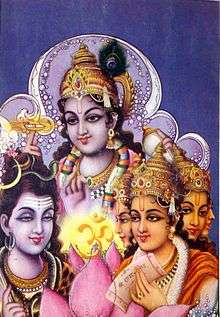 Lord Shiva, Lord Vishnu and Lord Brahma | |
| Affiliation | Brahma (creator), Vishnu (preserver), and Shiva (destroyer) |
| Abode | Satyaloka abode of Brahma Vaikuntha abode of Vishnu Kailash abode of Shiva |
| Mantra | Om Tridevaya Namah |
| Weapon | Bramhastra and Kamandala (Brahma); Sudarshana and Kaumodaki (Vishnu); Trishula (Shiva) |
| Mount | Swan (mount of Brahma), Garuda (mount of Vishnu) and Nandi (mount of Shiva) |
| Consort | Tridevi which consists of Saraswati (Brahma's wife) Lakshmi (Vishnu's wife) Parvati (Shiva's wife) |
| Translations of Trimurti | |
|---|---|
| English | Three forms |
| Sanskrit | त्रिमूर्ति (Trimūrti) |
| Bengali | ত্রিমূর্তি (Trimūrti) |
| Hindi | त्रिमूर्ति (Trimūrti) |
| Javanese | ꦠꦿꦶꦩꦸꦂꦠꦶ (Trimurti) |
| Kannada | ತ್ರಿಮೂರ್ತಿ (Trimūrti) |
| Malayalam | ത്രിമൂർത്തികൾ (Trimūrttikaḷ) |
| Marathi | त्रिमूर्ती (Trimūrti) |
| Nepali | त्रिमूर्ति (Trimūrti) |
| Odia | ତ୍ରିମୂର୍ତ୍ତି (Trimūrti) |
| Punjabi | ਤ੍ਰੀਮੂਰਤੀ (trīmūratī) |
| Tamil | மும்மூர்த்திகள் (Mum'mūrttikaḷ) |
| Telugu | త్రిమూర్తులు (Trimūrtulu) |
| Glossary of Hinduism | |
Evolution
 Trimurti with Tridevi
Trimurti with Tridevi- An art depiction of the Trimurti at the Hoysaleswara temple in Halebidu
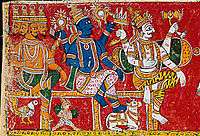 Trimurti, painting from Andhra Pradesh
Trimurti, painting from Andhra Pradesh
The Puranic period saw the rise of post-Vedic religion and the evolution of what R. C. Majumdar calls "synthetic Hinduism".[9]
This period had no homogeneity, and included orthodox Brahmanism in the form of remnants of older Vedic faith traditions, along with different sectarian religions, notably Shaivism, Vaishnavism, and Shaktism that were within the orthodox fold yet still formed distinct entities.[10] One of the important traits of this period is a spirit of harmony between orthodox and sectarian forms.[11] Regarding this spirit of reconciliation, R. C. Majumdar says that:
Its most notable expression is to be found in the theological conception of the Trimūrti, i.e., the manifestation of the supreme God in three forms of Brahmā, Viṣṇu, and Śiva... But the attempt cannot be regarded as a great success, for Brahmā never gained an ascendancy comparable to that of Śiva or Viṣṇu, and the different sects often conceived the Trimūrti as really the three manifestations of their own sectarian god, whom they regarded as Brahman or Absolute.[12]
However, this argument overlooks the obvious correlation of Brahmā with Brahman. The identification of Brahma, Vishnu, and Shiva as one being is strongly emphasized in the Kūrma Purāṇa, wherein 1.6 Brahman is worshipped as Trimurti; 1.9 especially inculcates the unity of the three gods, and 1.26 relates to the same theme.[13] Historian A. L. Basham explains the background of the Trimurti as follows, noting Western interest in the idea of trinity:
There must be some doubt as to whether the Hindu tradition has ever recognized Brahma as the Supreme Deity in the way that Visnu and Siva have been conceived of and worshiped.[14]
The concept of Trimurti is also present in the Maitri Upanishad, where the three gods are explained as three of his supreme forms.[15]
Trimurti temples
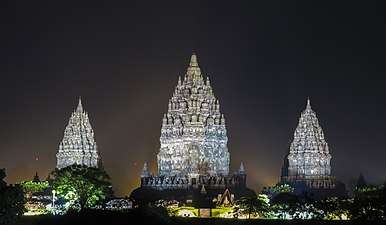
Temples dedicated to various permutations of the Trimurti can be seen as early as the 6th century C.E., and there are still some temples today in which the Trimurti are actively worshiped.
Views within Hinduism
In general it can be said that the trimurti has less of a role in the Hinduism of recent centuries than in ancient India.
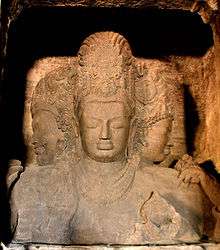 Trimurti sculpture on Gharapuri Island.
Trimurti sculpture on Gharapuri Island.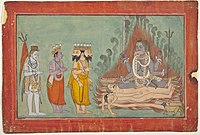 Shiva, Vishnu, and Brahma adoring Kali.
Shiva, Vishnu, and Brahma adoring Kali..jpg) Trimurti from Angkor. Made of sandstone, statue dates back to the 11th century. On display at the National Museum of Cambodia.
Trimurti from Angkor. Made of sandstone, statue dates back to the 11th century. On display at the National Museum of Cambodia.
Shaivism
Shaivites hold that, according to Shaiva Agama, Shiva performs five actions - creation, preservation, dissolution, concealing grace, and revealing grace. Respectively, these first three actions are associated with Shiva as Sadyojata (akin to Brahma), Vamadeva (akin to Vishnu) and Aghora (akin to Rudra). Thus, Brahma, Vishnu and Rudra are not deities different from Shiva, but rather are forms of Shiva. As Brahma/Sadyojata, Shiva creates. As Vishnu/Vamadeva, Shiva preserves. As Rudra/Aghora, he dissolves. This stands in contrast to the idea that Shiva is the "God of destruction". Shiva is the supreme God and performs all actions, of which destruction is only but one. He is the first Brahman. The consort of Adi Parashakti. The timeless being. Shiva is beyond space and time. He is the one who can stop time. Shiva is none but all. Shiva is the smallest yet the biggest. The supreme being in all eternity. Ergo, the Trimurti is a form of Shiva Himself for Shaivas. Shaivites believe that Lord Shiva is the Supreme, who assumes various critical roles and assumes appropriate names and forms, and also stands transcending all these. A prominent visual example of a Shaivite version of the Trimurti is the Trimurti Sadashiva sculpture in the Elephanta Caves on Gharapuri Island.
Vaishnavism

Despite the fact that the Vishnu Purana describes that Vishnu manifests as Brahma in order to create and as Rudra (Shiva) in order to destroy,[16] Vaishnavism generally does not acknowledge the Trimurti concept; instead, they believe in the avataras of Vishnu like Buddha, Rama, Krishna, etc. They also believe that Shiva and Brahma both are forms of Vishnu. For example, the Dvaita school holds Vishnu alone to be the supreme God, with Shiva subordinate, and interprets the Puranas differently. For example, Vijayindra Tîrtha, a Dvaita scholar interprets the 18 puranas differently. He interprets the Vaishnavite puranas as satvic and Shaivite puranas as tamasic and that only satvic puranas are considered to be authoritative.[17]
Shaktism
The Female-Centric Shaktidharma denomination assigns the eminent roles of the three forms (Trimurti) of Supreme Divinity not to masculine gods but instead to feminine goddesses: Mahasarasvati (Creatrix), Mahalaxmi (Preservatrix), and Mahakali (Destructrix). This feminine version of the Trimurti is called Tridevi ("three goddesses"). The masculine gods (Brahma, Vishnu, Shiva) are then relegated as auxiliary agents of the supreme feminine Tridevi. In Srimad Devi Bhagwat Purana's 1st book and 4th chapter. Devi addressed Trimurti as follows:
"I am Adi Parashakti. I am the owner of this universe. I am the Absolute Reality. I am dynamic in feminine form and static in masculine form. You have appeared to govern the universe through my energy. You are the masculine form of Absolute Reality, while I am the feminine form of that Reality. I am beyond form, beyond everything, and all the powers of God are contained within me. You must know that I am the Eternal limitless energy.
She then said: Brahma! You will be generator of the universe; the Goddess Sharada (Saraswati) is your consort, she will be recognized as the goddess of wisdom and the primeval sound. Lord Brahma, this goddess will be with you when you create the universe.
She continued: Lord Narayana (Krishna)! You are formless, yet you take form. I assign you to be the preserver of the universe. You will take a different incarnations in order to save this universe's inhabitants. Oh Narayana! You have created Lord Brahma, and Brahma will further create thirty three kind of gods and goddesses. I am goddess Mahamaya, has been reappear from your mystic sleep. Your consort will be goddess lakshmi. Lord Vishnu, this goddess will be with you when you rule/maintain the universe. When life evolves, you will take the form of Vishnu, the one who will perform the task of observing and preserving this universe.
At Last she instructed: "Oh Lord Rudra Shiv, the Great God, you are the personification of time, which is above all. You will perform the task of destroying and regenerating this universe. When you are formless, time stands still. It is due to my power that you become dynamic and are capable of bringing about the destruction and regeneration of this universe. Mahakali is myself, my full form, whereas Laxmi and Saraswati are just my clone, partial form but due to meditation, you will surpass all my forms. It is then that I will incarnate from your left half in my manifested form. This form will be my truest manifested form. Lord Shiva, she will perform the task of destroying evil and will be your consort.
Smartism
Smartism is a denomination of Hinduism that places emphasis on a group of five deities rather than just a single deity.[18] The "worship of the five forms" (pañcāyatana pūjā) system, which was popularized by the ninth-century philosopher Śankarācārya among orthodox Brahmins of the Smārta tradition, invokes the five deities Ganesha, Vishnu, Brahma, Shakti and Shiva.[19][20] Śankarācārya later added Kartikeya to these five, making six total. This reformed system was promoted by Śankarācārya primarily to unite the principal deities of the six major sects on an equal status.[21] The monistic philosophy preached by Śankarācārya made it possible to choose one of these as a preferred principal deity and at the same time worship the other four deities as different forms of the same all-pervading Brahman.
Sauram
The Saura sect that worships Surya as the supreme personality of the godhead and saguna brahman does not accept the Trimurti as they believe Surya is God. Earlier forms of the Trimurti sometimes included Surya instead of Brahma, or as a fourth above the Trimurti, of whom the other three are manifestations; Surya is Brahma in the morning, Vishnu in the afternoon and Shiva in the evening. Surya was also a member of the original Vedic Trimurti, which included Varuna and Vayu. Some Sauras worship either Vishnu or Brahma or Shiva as manifestations of Surya, others worship the Trimurti as a manifestation of Surya, and others exclusively worship Surya alone.
See also
- Dattatreya
- Moirai
- Om
- Tridevi
- Trinity
- Triple deities
Citations
- "Trimurti" Archived 29 November 2014 at the Wayback Machine. Random House Webster's Unabridged Dictionary.
- Grimes, John A. (1995). Ganapati: Song of the Self. SUNY Series in Religious Studies. Albany: State University of New York Press. ISBN 0-7914-2440-5.
- Jansen, Eva Rudy (2003). The Book of Hindu Imagery. Havelte, Holland: Binkey Kok Publications BV. ISBN 90-74597-07-6.
- Radhakrishnan, Sarvepalli (Editorial Chairman) (1956). The Cultural Heritage of India. Calcutta: The Ramakrishna Mission Institute of Culture.
- Winternitz, Maurice (1972). History of Indian Literature. New Delhi: Oriental Books Reprint Corporation.
- For quotation defining the trimurti see Matchett, Freda. I real all the three deities are avatar of Shiva. The Brahma is "Swetamber"(one who wears white clothes), Maha Vishnu is "Pitamber" (one who wears yellow/red/orange clothes) and the Shiva is "Digamber/Vaagamber"(one who doesn't wears any cloth, only the skin of tiger). "The Purāṇas", in: Flood (2003), p. 139.
- For the Trimurti system having Brahma as the creator, Vishnu as the maintainer or preserver, and Shiva as the destroyer. see Zimmer (1972) p. 124.
- Mhatre, Sandeep. "Datta Sampradaay and Their Vital Role". Swami Samarth temple. Archived from the original on 4 March 2016.
- For dating of Puranic period as c. CE 300-1200 and quotation, see: Majumdar, R. C. "Evolution of Religio-Philosophic Culture in India", in: Radhakrishnan (CHI, 1956), volume 4, p. 47.
- For characterization as non-homogeneous and including multiple traditions, see: Majumdar, R. C. "Evolution of Religio-Philosophic Culture in India", in: Radhakrishnan (CHI, 1956), volume 4, p. 49.
- For harmony between orthodox and sectarian groups, see: Majumdar, R. C. "Evolution of Religio-Philosophic Culture in India", in: Radhakrishnan (CHI, 1956), volume 4, p. 49.
- For quotation see: see: Majumdar, R. C. "Evolution of Religio-Philosophic Culture in India", in: Radhakrishnan (CHI, 1956), volume 4, p. 49.
- For references to Kūrma Purana see: Winternitz, volume 1, p. 573, note 2.
- Sutton, Nicholas (2000). Religious doctrines in the Mahābhārata (1st ed.). Delhi: Motilal Banarsidass Publishers. p. 182. ISBN 81-208-1700-1.
- "Brahma, Rudra, and Vishnu are called the supreme forms of him. His portion of darkness is! Rudra. His portion of passion is Brahma. His portion of purity is Visnu"—Maitri Upanishad [5.2]
- Flood, Gavin, An Introduction to Hinduism, Cambridge University Press, p. 111, ISBN 0-521-43878-0
- Sharma, B. N. Krishnamurti (2000). A history of the Dvaita school of Vedānta and its literature: from the earliest beginnings to our own times. Motilal Banarsidass Publishers. p. 412. ISBN 81-208-1575-0. Archived from the original on 24 December 2019. Retrieved 15 January 2010.
- Flood (1996), p. 17.
- Dating for the pañcāyatana pūjā and its connection with Smārta Brahmins is from Courtright, p. 163.
- For worship of the five forms as central to Smarta practice see: Flood (1996), p. 113.
- Grimes, p. 162.
General sources
- Basham, A. L. (1954). The Wonder That Was India: A Survey of the Culture of the Indian Sub-Continent Before the Coming of the Muslims. New York: Grove Press.
- Courtright, Paul B. (1985). Gaṇeśa: Lord of Obstacles, Lord of Beginnings. New York: Oxford University Press. ISBN 0-19-505742-2.
- Flood, Gavin (1996). An Introduction to Hinduism. Cambridge: Cambridge University Press. ISBN 0-521-43878-0.
- Flood, Gavin, ed. (2003). The Blackwell Companion to Hinduism. Malden, MA: Blackwell Publishing. ISBN 1-4051-3251-5.
- Zimmer, Heinrich (1972). Myths and Symbols in Indian Art and Civilization. Princeton, New Jersey: Princeton University Press. ISBN 0-691-01778-6.
External links


